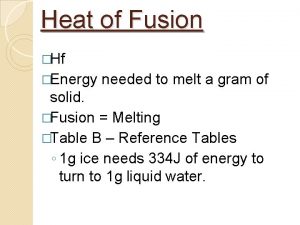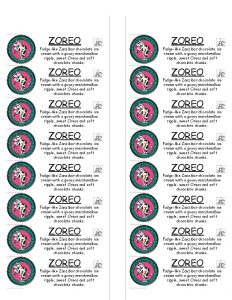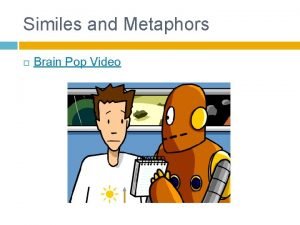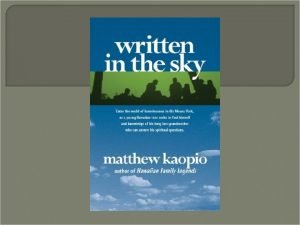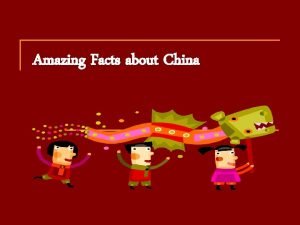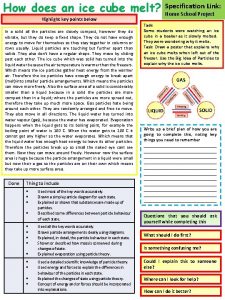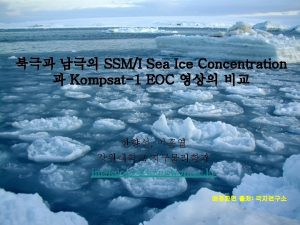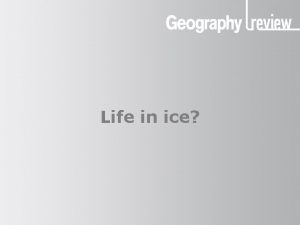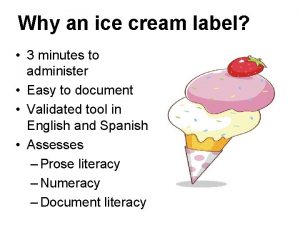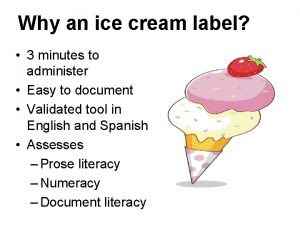Why does my ice cream melt so fast

































- Slides: 33


Why does my ice cream melt so fast?

Global Warming In recent years, more and more scientists have found evidence that the world's climate is becoming warmer. They believe this global warming is due largely to the pollution of the atmosphere by human activities.

Record-breaking weather One of the effects of global warming appears to be a succession of record-breaking weather events and extreme weather. Data collected from weather and climate stations, satellites, ships, buoys and floats show that the 2003 world average temperature was the second warmest recorded, although it was cooler than the record warm year of 1998. The ten warmest years have all occurred since 1990.

Heat waves and Fl. Oo. Di. NG During 2003, temperatures were 1. 7' C/ 35. 06' F above average across large parts of Asia, Europe and the western United States. Warmer-than-average temperatures also affected much of South America, Australia, Canada and parts of Africa. In the eastern United States, western Asia, and coastal areas of Australia many areas had cooler-than-average temperatures.

heat waves and flooding There was a record-breaking summer heat wave in Europe, and France had its warmest summer on record. More than 1, 400 French people died of heat-related causes in late July and August. Temperatures also soared across southern Asia in late may and June. During a 20 -day heat wave, temperatures reached 4550' C/ 113 -122' F, and more than 1, 500 people died in India.

heat waves and flooding Temperatures in north-western Russia were as low as -45' C/ -49' F in January 2003 and parts of the Baltic sea began to freeze. Thousands of deaths were caused by extreme cold in India and Bangladesh during January. Snow fell during June in Moscow for the first time since 1963. In the Peruvian highlands temperatures dropped below -20' C/ -4' F during July, and 200 people died. Santa Fe in Argentina had severe flooding after heavy rainfall in April and May. In South Korea heavy rains from typhoon Maemi in September triggered landslides and flooding, killing 130 people and forcing the evacuation of more than 25, 000.

The Human Population The Earth's atmosphere has served living things well for millions of years. Now the world is dominated by one species, Homo sapiens. People are so successful, from an evolutionary point of view, that now more than six billion of us share the planet, within the next 50 years the human population could rise to more than nine billion.

Teeming populations put pressure on the atmosphere and other parts of our planets life support systems. A major concern is the accumulation of gases in the atmosphere from the fuels we burn. Burning carbon-based fossil fuels and wood gives off carbon dioxide, methane and nitrous oxide which are all greenhouse gases.

The carbon cycle Carbon dioxide is one of the gases that make up the air we breathe. It is continuously created and destroyed and is part of the carbon cycle that includes all living organisms, the atmosphere, the oceans and the Earth's rocks. In the natural world, carbon is used over and over again.


Green plants are the only living things that can make their own food and they use carbon dioxide and water in photosynthesis. Plants take in carbon dioxide from the atmosphere and dissolved in surface water, particularly in the oceans. The oceans contain about 50 times more carbon dioxide than the atmosphere and act as a reservoir that helps keep the amount of carbon dioxide in the air at 0. 03%.

The carbon cycle The carbon in green plants is transferred to animals when they eat plants or other animals that have fed on plants. Animals and plants release carbon back into the air in the form of carbon dioxide when they breathe out. When they die they decompose, slowly releasing carbon dioxide into the atmosphere. Plant and animal remains can form fossil fuels and their. shells and skeletons can form limestone rocks

Human activity can disrupt the carbon cycle. We release carbon dioxide that would have remained locked up for long periods by burning wood, coal, oil or natural gas. We also interfere with the removal of carbon from the atmosphere by destroying forests. In 1987 an area of the Amazon rainforest the size of Britain was burned. This added 500 million tons of carbon dioxide to the atmosphere and removed a vast number of trees that could have absorbed carbon dioxide.


The greenhouse affect Heat from the Sun is absorbed by the Earth's surface. Most is radiated away from the Earth, and some escapes back into space. Carbon dioxide and some other gases let the Sun's energy pass through to the Earth, but trap the heat coming back from its surface. If gases such as carbon dioxide did not absorb some heat, the world would be much colder. The oceans would freeze and the average temperature would be -18'C/. 039' F.


The greenhouse affect Until recently natural levels of carbon dioxide had kept the Earth at a comfortable average temperature of 15'C/ 59' F for thousands of years. Since the start of the Industrial Revolution we have built up a chemical blanket of carbon dioxide and other gases that act like extra-thick glass in a greenhouse, trapping more of the heat that used to escape from the Earth into space. So the global temperature has increased.

The effects of global warming As temperatures rise, most climatologists believe the weather will continue to become more extreme. More water will evaporate from the oceans and seas, which will create more rain clouds and storms. There is evidence that we are experiencing more storms, hurricanes and tornadoes, but we do not know whether this is a long-term change. As precipitation and air pressure patterns shift, water may become scarcer where it is already in short supply and many low-lying parts of the world will suffer from flooding.

Melting Ice Almost four-fifths of all the fresh water on Earth is frozen solid in polar ice-sheets, icebergs, mountain glaciers and the snow and ice on mountain tops. Since the early twentieth century, most glaciers have retreated and their melt water has helped to raise sea levels by several millimeters a year. If global warming continues to melt the polar ice, sea levels will rise faster. Water, like everything else, expands as it heats up. So as the Earth becomes warmer, the water in the oceans will expand, raising sea levels further.

Global warming, wildlife and people Human diseases, such as malaria and cholera, and deaths from heat stroke and skin cancer seem likely to increase. Some kinds of plants and animals, which are not able to adapt to the new climatic conditions, will become extinct. Those species particularly at risk are those very sensitive to changes in temperature.

Global warming, wildlife and people One species that seems doomed if the sea ice continues to melt is the polar bear. Scientists estimate that one-fifth of the Arctic's summer sea ice could have melted by 2050. If that happens, polar bears will no longer be able to hunt, so will decline drastically. By contrast, it is possible that populations of pest species, such as rats, flies, mice and mosquitoes, whose numbers are normally reduced by cold winters, may rocket out of control.

Flooding The projected rise in sea levels of 30 cm by 2030 could affect about 200 million people worldwide. The United States would need to spread at least $450 million more a year on flood prevention measures. For low-lying countries such as Bangladesh, the Netherlands and many island states in the Indian and Pacific Oceans, it could mean disaster. The danger is not simply from flooding, but from increased coastal erosion, higher storm tides, flooding from backed-up rivers and increased salinity in freshwater supplies.

Islamic point of view Environmental crisis “When the earth is shaken with a (violent) shaking, And the earth reveals what burdens her, And man says: What has befallen her? On that day she shall tell her story…” (Qur'an 99: 1 -4)

Respect all creations of Allah Muslims should seek to protect and preserve the environment because by so doing they protect Allah's creatures which pray to Him and praise Him. Humankind might not be able to understand how these creatures praise Allah but this does not mean that they do not do so, Allah says: The seven heavens and the earth, and all beings therein, declare His glory: There is not a thing but celebrates His praise, and yet ye understand not how they declare His Glory! Quran 17: 44

“No creature is there on earth nor a bird flying with its wings but they are nations like you” [6: 38] “Surely the creation of the heavens and the earth is greater than the creation of man; but most people know not” [40: 57]

“The earth has been created for me as a mosque and as a means of purification. ” [Al-Bukhari I: 331] The Prophet emphasizes the sacred nature of earth or soil, not only as a pure entity but also as a purifying agent. This reverence towards soil is also demonstrated in the ritual of tayammum. In the harsh desert environment where the Prophet lived, water was synonymous to life. Water was a gift from God, the source of all life on earth as is testified in the Qur’an: “We made from water every living thing” [21: 30].

The Qur’an constantly reminds believers that they are but the guardians of God’s creation on earth and that they should never take this creation for granted: “Consider the water which you drink. Was it you that brought it down from the rain cloud or We? If We had pleased, We could make it bitter” [56: 68 -70]

Man and nature Man is endowed with a higher intelligence than the rest of creation. Because of this he must assume a role of guardianship over the rest of creation and interact with nature in a way that is worthy of this intelligence.

In the Islamic world-view the relationship of man with nature should be like that of a just ruler with his subjects. Although the ruler has power over his subjects, his subjects are a trust over which he stands guard. He is expected to act in a responsible way toward them. Misuse and abuse of his power would shift him from being a leader to being a tyrant. The end result of tyranny is nothing but a revolt against the tyrant. This is precisely what is happening between man the tyrant and nature the tyrannized.

Nature has been made subservient to man, but it is as much a creature of God as man is. Neither has man created nature nor is he in any way able to sustain it. It is only because God has given him the sufficiency and capacity can he in any way do so. If he is able to plant a tree and administer its growth or manipulate its genetic characteristics, it is only because of the intelligence placed within him by God.

Just as God has been good to man so also man must act with the same beneficence toward nature so that he may safeguard himself when facing God.

Video Links: http: //www. climatechallenge. gov. uk/multimedia/film. html http: //www. youtube. com/watch? v=t. GNJ 42 nt_Xk&mode=related &search
 Melting different types of chocolate experiment
Melting different types of chocolate experiment What is nasreen putting chocolate on?
What is nasreen putting chocolate on? Does cold stone coffee ice cream have caffeine
Does cold stone coffee ice cream have caffeine Pictures
Pictures Measuring heat energy
Measuring heat energy Zoreo
Zoreo Writing a yummy paragraph
Writing a yummy paragraph Specific heat capacity of ice cream
Specific heat capacity of ice cream Simile like or as
Simile like or as Cinquain poem rules
Cinquain poem rules The chocolate ice cream is calling my name
The chocolate ice cream is calling my name Ice cream paper mache
Ice cream paper mache Miss mary mack origin
Miss mary mack origin Supply chain of ice cream
Supply chain of ice cream Ice cream lab chemistry
Ice cream lab chemistry Ice cream group
Ice cream group When was butter pecan ice cream invented
When was butter pecan ice cream invented Heaps of love
Heaps of love Weights of the backpacks of first graders on a school bus.
Weights of the backpacks of first graders on a school bus. Claes oldenburg pastry case i 1961 62
Claes oldenburg pastry case i 1961 62 Cake is a countable or uncountable noun
Cake is a countable or uncountable noun Ice cream target market
Ice cream target market Click the arrow
Click the arrow Supply chain management in ice cream industry
Supply chain management in ice cream industry Frusen glädjé flavors
Frusen glädjé flavors Ice cream flavors a to z
Ice cream flavors a to z Isle of arran ice cream
Isle of arran ice cream And ice cream
And ice cream Kate likes to eat an ice cream
Kate likes to eat an ice cream Impulse unilever
Impulse unilever Ice cream supply chain
Ice cream supply chain Steelers ice cream
Steelers ice cream Ice cream manufacturing software
Ice cream manufacturing software Chinese invented ice cream
Chinese invented ice cream




